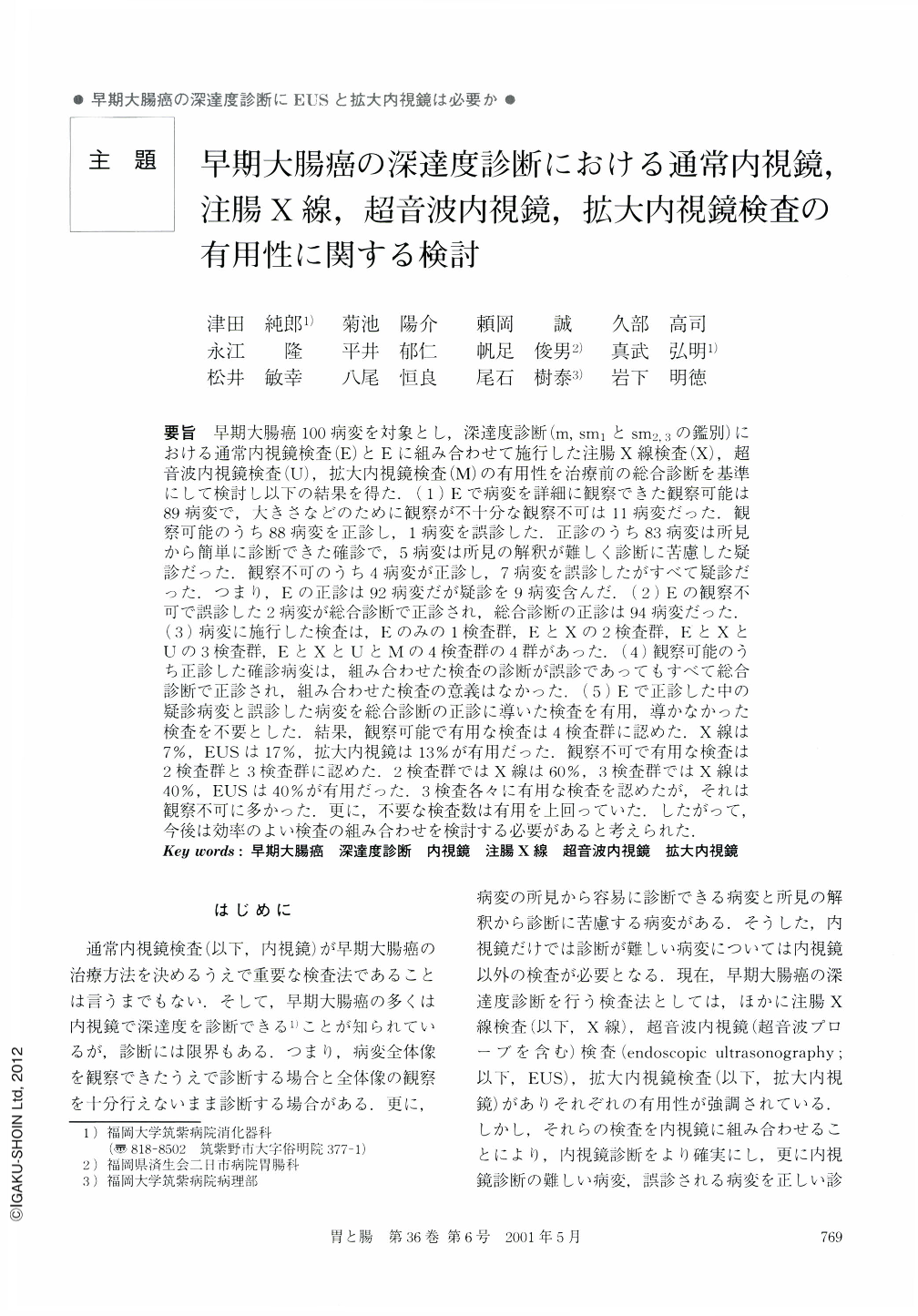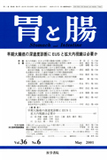Japanese
English
- 有料閲覧
- Abstract 文献概要
- 1ページ目 Look Inside
- サイト内被引用 Cited by
要旨 早期大腸癌100病変を対象とし,深達度診断(m,sm1とsm2,3の鑑別)における通常内視鏡検査(E)とEに組み合わせて施行した注腸X線検査(X),超音波内視鏡検査(U),拡大内視鏡検査(M)の有用性を治療前の総合診断を基準にして検討し以下の結果を得た.(1)Eで病変を詳細に観察できた観察可能は89病変で,大きさなどのために観察が不十分な観察不可は11病変だった.観察可能のうち88病変を正診し,1病変を誤診した.正診のうち83病変は所見から簡単に診断できた確診で,5病変は所見の解釈が難しく診断に苦慮した疑診だった.観察不可のうち4病変が正診し,7病変を誤診したがすべて疑診だった.つまり,Eの正診は92病変だが疑診を9病変含んだ.(2)Eの観察不可で誤診した2病変が総合診断で正診され,総合診断の正診は94病変だった.(3)病変に施行した検査は,Eのみの1検査群,EとXの2検査群,EとXとUの3検査群,EとXとUとMの4検査群の4群があった.(4)観察可能のうち正診した確診病変は,組み合わせた検査の診断が誤診であってもすべて総合診断で正診され,組み合わせた検査の意義はなかった.(5)Eで正診した中の疑診病変と誤診した病変を総合診断の正診に導いた検査を有用,導かなかった検査を不要とした.結果,観察可能で有用な検査は4検査群に認めた.X線は7%,EUSは17%,拡大内視鏡は13%が有用だった.観察不可で有用な検査は2検査群と3検査群に認めた.2検査群ではX線は60%,3検査群ではX線は40%,EUSは40%が有用だった.3検査各々に有用な検査を認めたが,それは観察不可に多かった.更に,不要な検査数は有用を上回っていた.したがって,今後は効率のよい検査の組み合わせを検討する必要があると考えられた.
The usefulness of conventional endoscopy (CE), barium enema (BE), endoscopic ultrasonography (EUS) and magnifying endoscopy (ME) for the diagnosis of depth of invasion (discrimination between m & sm1 and sm2 & sm3 tumors) was studied in 100 lesions of early colorectal cancer. BE, EUS and ME were carried out in combination with CE. The results were evaluated on the basis of the pre-treatment comprehensive diagnosis made by the combination of each examination. The results, obtained were as follows.
(1) Satisfactory observation by CE was possible in 89 lesions (satisfactory observation) but in the remaining 11 lesions observation was unsatisfactory due to their size and location (unsatisfactory observation). Correct diagnosis was made in 88 of the 89 lesions with satisfactory observation. In 83 of those 88 lesions definite diagnosis was made (definite diagnosis), but, for the other five lesions, the diagnosis was not definite due to the difficulty of interpretation of findings (probable diagnosis). In four of the 11 lesions with unsatisfactory observation the diagnosis was correct and, in the other seven, it was incorrect. Accordingly, the diagnosis by CE was correct in 92 lesions, but, in nine of them, it was probable diagnosis.
(2) In two of the seven incorrectly diagnosed lesions with unsatisfactory observation correct diagnosis was able to be made by the combination of each examination.
(3) The variety of the combination in each examination was as follows ; CE only (one-examination group), CE and BE (two-examination group), CE, BE and EUS (three-examination group) and CE, BE, EUS and ME (four-examination group).
(4) In all lesions of “satisfactory” observation with definite diagnosis the comprehensive diagnosis was correct, even if incorrect diagnosis had been made by one method in each examination. Therefore, there was no significance in the combination of examinations in this group.
(5) On evaluation of the correctly diagnosed lesions with probable diagnosis and those incorrectly diagnosed, each examination which led to correct diagnosis by the combination of examinations was defined as “useful ”and those which did not as “useless”. In lesions with satisfactory observation, useful examinations were made in the “four-examination” group. BE,EUS and ME were useful in 7%, 17% and 13% respectively, of the lesions examined. In lesions of “unsatisfactory” observation, useful examinations were made in both the two and three-examination groups. In the two-examination group,60% of BE was useful, and in the three-examination group, 40% of BE and 40% of EUS were useful. Namely, each examination was useful in some lesions, but, many of them were of “unsatisfactory” observation. Moreover, the number of useless examinations exceeded that of useful examinations. Therefore, it seems necessary to seek for more efficient combinations of examinations.

Copyright © 2001, Igaku-Shoin Ltd. All rights reserved.


